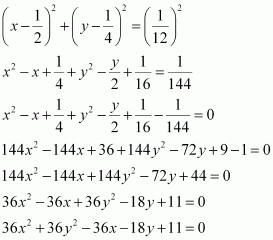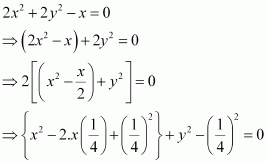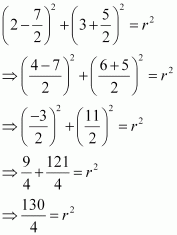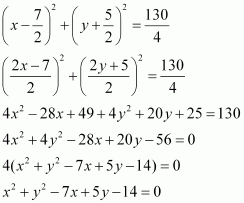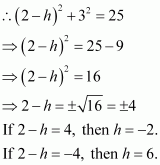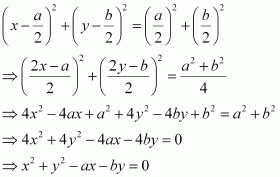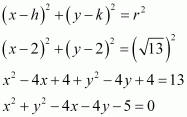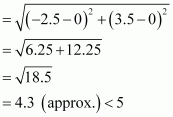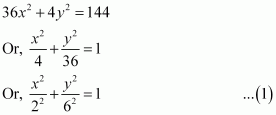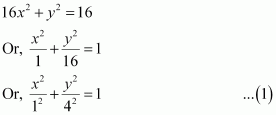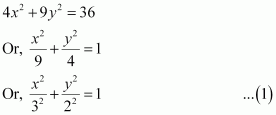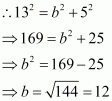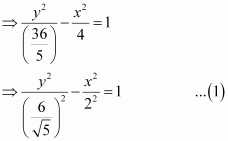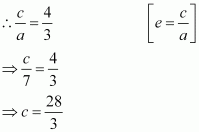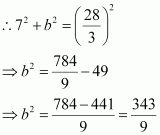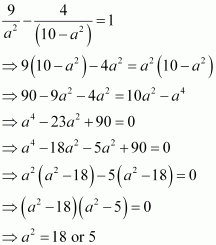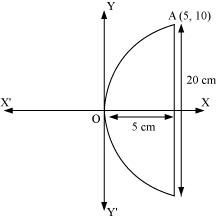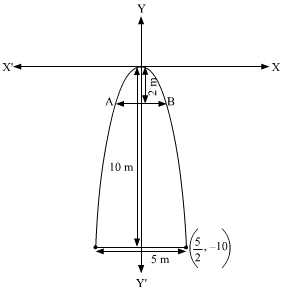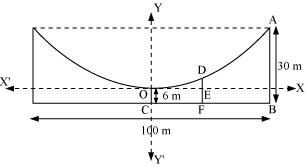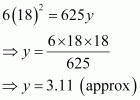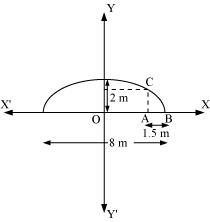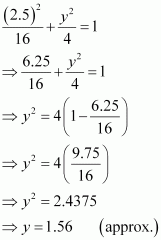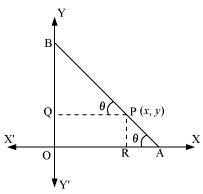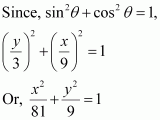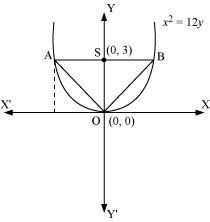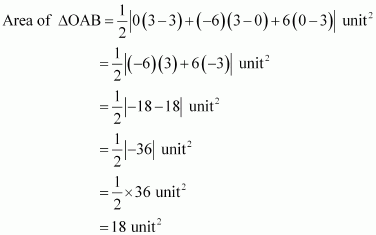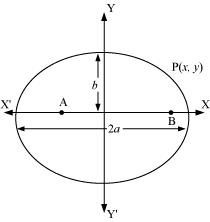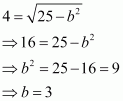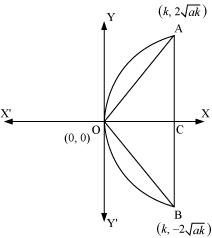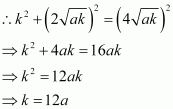NCERT Solutions for Class 11 Maths Chapter 11 – Conic Sections
Page No 241:
Question 1:
Find the equation of the circle with centre (0, 2) and radius 2
ANSWER:
The equation of a circle with centre (h, k) and radius r is given as
(x – h)2 + (y – k)2 = r2
It is given that centre (h, k) = (0, 2) and radius (r) = 2.
Therefore, the equation of the circle is
(x – 0)2 + (y – 2)2 = 22
x2 + y2 + 4 – 4 y = 4
x2 + y2 – 4y = 0
Page No 241:
Question 2:
Find the equation of the circle with centre (–2, 3) and radius 4
ANSWER:
The equation of a circle with centre (h, k) and radius r is given as
(x – h)2 + (y – k)2 = r2
It is given that centre (h, k) = (–2, 3) and radius (r) = 4.
Therefore, the equation of the circle is
(x + 2)2 + (y – 3)2 = (4)2
x2 + 4x + 4 + y2 – 6y + 9 = 16
x2 + y2 + 4x – 6y – 3 = 0
Page No 241:
Question 3:
Find the equation of the circle with centreand radius
ANSWER:
The equation of a circle with centre (h, k) and radius r is given as
(x – h)2 + (y – k)2 = r2
It is given that centre (h, k) = and radius (r) =
.
Therefore, the equation of the circle is
Page No 241:
Question 4:
Find the equation of the circle with centre (1, 1) and radius
ANSWER:
The equation of a circle with centre (h, k) and radius r is given as
(x – h)2 + (y – k)2 = r2
It is given that centre (h, k) = (1, 1) and radius (r) =.
Therefore, the equation of the circle is
Page No 241:
Question 5:
Find the equation of the circle with centre (–a, –b) and radius
ANSWER:
The equation of a circle with centre (h, k) and radius r is given as
(x – h)2 + (y – k)2 = r2
It is given that centre (h, k) = (–a, –b) and radius (r) =.
Therefore, the equation of the circle is
Page No 241:
Question 6:
Find the centre and radius of the circle (x + 5)2 + (y – 3)2 = 36
ANSWER:
The equation of the given circle is (x + 5)2 + (y – 3)2 = 36.
(x + 5)2 + (y – 3)2 = 36
⇒ {x – (–5)}2 + (y – 3)2 = 62, which is of the form (x – h)2 + (y – k)2 = r2, where h = –5, k = 3, and r = 6.
Thus, the centre of the given circle is (–5, 3), while its radius is 6.
Page No 241:
Question 7:
Find the centre and radius of the circle x2 + y2 – 4x – 8y – 45 = 0
ANSWER:
The equation of the given circle is x2 + y2 – 4x – 8y – 45 = 0.
x2 + y2 – 4x – 8y – 45 = 0
⇒ (x2 – 4x) + (y2 – 8y) = 45
⇒ {x2 – 2(x)(2) + 22} + {y2 – 2(y)(4)+ 42} – 4 –16 = 45
⇒ (x – 2)2 + (y –4)2 = 65
⇒ (x – 2)2 + (y –4)2 = , which is of the form (x – h)2 + (y – k)2 = r2, where h = 2, k = 4, and
.
Thus, the centre of the given circle is (2, 4), while its radius is.
Page No 241:
Question 8:
Find the centre and radius of the circle x2 + y2 – 8x + 10y – 12 = 0
ANSWER:
The equation of the given circle is x2 + y2 – 8x + 10y – 12 = 0.
x2 + y2 – 8x + 10y – 12 = 0
⇒ (x2 – 8x) + (y2 + 10y) = 12
⇒ {x2 – 2(x)(4) + 42} + {y2 + 2(y)(5) + 52}– 16 – 25 = 12
⇒ (x – 4)2 + (y + 5)2 = 53
, which is of the form (x – h)2 + (y – k)2 = r2, where h = 4, k = –5, and
.
Thus, the centre of the given circle is (4, –5), while its radius is.
Page No 241:
Question 9:
Find the centre and radius of the circle 2x2 + 2y2 – x = 0
ANSWER:
The equation of the given circle is 2x2 + 2y2 – x = 0.
, which is of the form (x – h)2 + (y – k)2 = r2, where h =
, k = 0, and
.
Thus, the centre of the given circle is, while its radius is
.
Page No 241:
Question 10:
Find the equation of the circle passing through the points (4, 1) and (6, 5) and whose centre is on the line 4x + y = 16.
ANSWER:
Let the equation of the required circle be (x – h)2 + (y – k)2 = r2.
Since the circle passes through points (4, 1) and (6, 5),
(4 – h)2 + (1 – k)2 = r2 … (1)
(6 – h)2 + (5 – k)2 = r2 … (2)
Since the centre (h, k) of the circle lies on line 4x + y = 16,
4h + k = 16 … (3)
From equations (1) and (2), we obtain
(4 – h)2 + (1 – k)2 = (6 – h)2 + (5 – k)2
⇒ 16 – 8h + h2 + 1 – 2k + k2 = 36 – 12h + h2 + 25 – 10k + k2
⇒ 16 – 8h + 1 – 2k = 36 – 12h + 25 – 10k
⇒ 4h + 8k = 44
⇒ h + 2k = 11 … (4)
On solving equations (3) and (4), we obtain h = 3 and k = 4.
On substituting the values of h and k in equation (1), we obtain
(4 – 3)2 + (1 – 4)2 = r2
⇒ (1)2 + (– 3)2 = r2
⇒ 1 + 9 = r2
⇒ r2 = 10
⇒
Thus, the equation of the required circle is
(x – 3)2 + (y – 4)2 =
x2 – 6x + 9 + y2 – 8y + 16 = 10
x2 + y2 – 6x – 8y + 15 = 0
Page No 241:
Question 11:
Find the equation of the circle passing through the points (2, 3) and (–1, 1) and whose centre is on the line x – 3y – 11 = 0.
ANSWER:
Let the equation of the required circle be (x – h)2 + (y – k)2 = r2.
Since the circle passes through points (2, 3) and (–1, 1),
(2 – h)2 + (3 – k)2 = r2 … (1)
(–1 – h)2 + (1 – k)2 = r2 … (2)
Since the centre (h, k) of the circle lies on line x – 3y – 11 = 0,
h – 3k = 11 … (3)
From equations (1) and (2), we obtain
(2 – h)2 + (3 – k)2 = (–1 – h)2 + (1 – k)2
⇒ 4 – 4h + h2 + 9 – 6k + k2 = 1 + 2h + h2 + 1 – 2k + k2
⇒ 4 – 4h + 9 – 6k = 1 + 2h + 1 – 2k
⇒ 6h + 4k = 11 … (4)
On solving equations (3) and (4), we obtain.
On substituting the values of h and k in equation (1), we obtain
Thus, the equation of the required circle is
Page No 241:
Question 12:
Find the equation of the circle with radius 5 whose centre lies on x-axis and passes through the point (2, 3).
ANSWER:
Let the equation of the required circle be (x – h)2 + (y – k)2 = r2.
Since the radius of the circle is 5 and its centre lies on the x-axis, k = 0 and r = 5.
Now, the equation of the circle becomes (x – h)2 + y2 = 25.
It is given that the circle passes through point (2, 3).
When h = –2, the equation of the circle becomes
(x + 2)2 + y2 = 25
x2 + 4x + 4 + y2 = 25
x2 + y2 + 4x – 21 = 0
When h = 6, the equation of the circle becomes
(x – 6)2 + y2 = 25
x2 – 12x +36 + y2 = 25
x2 + y2 – 12x + 11 = 0
Page No 241:
Question 13:
Find the equation of the circle passing through (0, 0) and making intercepts a and b on the coordinate axes.
ANSWER:
Let the equation of the required circle be (x – h)2 + (y – k)2 = r2.
Since the circle passes through (0, 0),
(0 – h)2 + (0 – k)2 = r2
⇒ h2 + k2 = r2
The equation of the circle now becomes (x – h)2 + (y – k)2 = h2 + k2.
It is given that the circle makes intercepts a and b on the coordinate axes. This means that the circle passes through points (a, 0) and (0, b). Therefore,
(a – h)2 + (0 – k)2 = h2 + k2 … (1)
(0 – h)2 + (b – k)2 = h2 + k2 … (2)
From equation (1), we obtain
a2 – 2ah + h2 + k2 = h2 + k2
⇒ a2 – 2ah = 0
⇒ a(a – 2h) = 0
⇒ a = 0 or (a – 2h) = 0
However, a ≠ 0; hence, (a – 2h) = 0 ⇒ h =.
From equation (2), we obtain
h2 + b2 – 2bk + k2 = h2 + k2
⇒ b2 – 2bk = 0
⇒ b(b – 2k) = 0
⇒ b = 0 or(b – 2k) = 0
However, b ≠ 0; hence, (b – 2k) = 0 ⇒ k =.
Thus, the equation of the required circle is
Page No 241:
Question 14:
Find the equation of a circle with centre (2, 2) and passes through the point (4, 5).
ANSWER:
The centre of the circle is given as (h, k) = (2, 2).
Since the circle passes through point (4, 5), the radius (r) of the circle is the distance between the points (2, 2) and (4, 5).
Thus, the equation of the circle is
Page No 241:
Question 15:
Does the point (–2.5, 3.5) lie inside, outside or on the circle x2 + y2 = 25?
ANSWER:
The equation of the given circle is x2 + y2 = 25.
x2 + y2 = 25
⇒ (x – 0)2 + (y – 0)2 = 52, which is of the form (x – h)2 + (y – k)2 = r2, where h = 0, k = 0, and r = 5.
∴Centre = (0, 0) and radius = 5
Distance between point (–2.5, 3.5) and centre (0, 0)
Since the distance between point (–2.5, 3.5) and centre (0, 0) of the circle is less than the radius of the circle, point (–2.5, 3.5) lies inside the circle.
Page No 246:
Question 1:
Find the coordinates of the focus, axis of the parabola, the equation of directrix and the length of the latus rectum for y2 = 12x
ANSWER:
The given equation is y2 = 12x.
Here, the coefficient of x is positive. Hence, the parabola opens towards the right.
On comparing this equation with y2 = 4ax, we obtain
4a = 12 ⇒ a = 3
∴Coordinates of the focus = (a, 0) = (3, 0)
Since the given equation involves y2, the axis of the parabola is the x-axis.
Equation of direcctrix, x = –a i.e., x = – 3 i.e., x + 3 = 0
Length of latus rectum = 4a = 4 × 3 = 12
Page No 246:
Question 2:
Find the coordinates of the focus, axis of the parabola, the equation of directrix and the length of the latus rectum for x2 = 6y
ANSWER:
The given equation is x2 = 6y.
Here, the coefficient of y is positive. Hence, the parabola opens upwards.
On comparing this equation with x2 = 4ay, we obtain
∴Coordinates of the focus = (0, a) =
Since the given equation involves x2, the axis of the parabola is the y-axis.
Equation of directrix,
Length of latus rectum = 4a = 6
Page No 246:
Question 3:
Find the coordinates of the focus, axis of the parabola, the equation of directrix and the length of the latus rectum for y2 = – 8x
ANSWER:
The given equation is y2 = –8x.
Here, the coefficient of x is negative. Hence, the parabola opens towards the left.
On comparing this equation with y2 = –4ax, we obtain
–4a = –8 ⇒ a = 2
∴Coordinates of the focus = (–a, 0) = (–2, 0)
Since the given equation involves y2, the axis of the parabola is the x-axis.
Equation of directrix, x = a i.e., x = 2
Length of latus rectum = 4a = 8
Page No 246:
Question 4:
Find the coordinates of the focus, axis of the parabola, the equation of directrix and the length of the latus rectum for x2 = – 16y
ANSWER:
The given equation is x2 = –16y.
Here, the coefficient of y is negative. Hence, the parabola opens downwards.
On comparing this equation with x2 = – 4ay, we obtain
–4a = –16 ⇒ a = 4
∴Coordinates of the focus = (0, –a) = (0, –4)
Since the given equation involves x2, the axis of the parabola is the y-axis.
Equation of directrix, y = a i.e., y = 4
Length of latus rectum = 4a = 16
Page No 246:
Question 5:
Find the coordinates of the focus, axis of the parabola, the equation of directrix and the length of the latus rectum for y2 = 10x
ANSWER:
The given equation is y2 = 10x.
Here, the coefficient of x is positive. Hence, the parabola opens towards the right.
On comparing this equation with y2 = 4ax, we obtain
∴Coordinates of the focus = (a, 0)
Since the given equation involves y2, the axis of the parabola is the x-axis.
Equation of directrix,
Length of latus rectum = 4a = 10
Page No 246:
Question 6:
Find the coordinates of the focus, axis of the parabola, the equation of directrix and the length of the latus rectum for x2 = –9y
ANSWER:
The given equation is x2 = –9y.
Here, the coefficient of y is negative. Hence, the parabola opens downwards.
On comparing this equation with x2 = –4ay, we obtain
∴Coordinates of the focus =
Since the given equation involves x2, the axis of the parabola is the y-axis.
Equation of directrix,
Length of latus rectum = 4a = 9
Page No 247:
Question 7:
Find the equation of the parabola that satisfies the following conditions: Focus (6, 0); directrix x = –6
ANSWER:
Focus (6, 0); directrix, x = –6
Since the focus lies on the x-axis, the x-axis is the axis of the parabola.
Therefore, the equation of the parabola is either of the form y2 = 4ax or
y2 = – 4ax.
It is also seen that the directrix, x = –6 is to the left of the y-axis, while the focus (6, 0) is to the right of the y-axis. Hence, the parabola is of the form y2 = 4ax.
Here, a = 6
Thus, the equation of the parabola is y2 = 24x.
Page No 247:
Question 8:
Find the equation of the parabola that satisfies the following conditions: Focus (0, –3); directrix y = 3
ANSWER:
Focus = (0, –3); directrix y = 3
Since the focus lies on the y-axis, the y-axis is the axis of the parabola.
Therefore, the equation of the parabola is either of the form x2 = 4ay or
x2 = – 4ay.
It is also seen that the directrix, y = 3 is above the x-axis, while the focus
(0, –3) is below the x-axis. Hence, the parabola is of the form x2 = –4ay.
Here, a = 3
Thus, the equation of the parabola is x2 = –12y.
Page No 247:
Question 9:
Find the equation of the parabola that satisfies the following conditions: Vertex (0, 0); focus (3, 0)
ANSWER:
Vertex (0, 0); focus (3, 0)
Since the vertex of the parabola is (0, 0) and the focus lies on the positive x-axis, x-axis is the axis of the parabola, while the equation of the parabola is of the form y2 = 4ax.
Since the focus is (3, 0), a = 3.
Thus, the equation of the parabola is y2 = 4 × 3 × x, i.e., y2 = 12x
Page No 247:
Question 10:
Find the equation of the parabola that satisfies the following conditions: Vertex (0, 0) focus (–2, 0)
ANSWER:
Vertex (0, 0) focus (–2, 0)
Since the vertex of the parabola is (0, 0) and the focus lies on the negative x-axis, x-axis is the axis of the parabola, while the equation of the parabola is of the form y2 = –4ax.
Since the focus is (–2, 0), a = 2.
Thus, the equation of the parabola is y2 = –4(2)x, i.e., y2 = –8x
Page No 247:
Question 11:
Find the equation of the parabola that satisfies the following conditions: Vertex (0, 0) passing through (2, 3) and axis is along x-axis
ANSWER:
Since the vertex is (0, 0) and the axis of the parabola is the x-axis, the equation of the parabola is either of the form y2 = 4ax or y2 = –4ax.
The parabola passes through point (2, 3), which lies in the first quadrant.
Therefore, the equation of the parabola is of the form y2 = 4ax, while point
(2, 3) must satisfy the equation y2 = 4ax.
Thus, the equation of the parabola is
Page No 247:
Question 12:
Find the equation of the parabola that satisfies the following conditions: Vertex (0, 0), passing through (5, 2) and symmetric with respect to y-axis
ANSWER:
Since the vertex is (0, 0) and the parabola is symmetric about the y-axis, the equation of the parabola is either of the form x2 = 4ay or x2 = –4ay.
The parabola passes through point (5, 2), which lies in the first quadrant.
Therefore, the equation of the parabola is of the form x2 = 4ay, while point
(5, 2) must satisfy the equation x2 = 4ay.
Thus, the equation of the parabola is
Page No 255:
Question 1:
Find the coordinates of the foci, the vertices, the length of major axis, the minor axis, the eccentricity and the length of the latus rectum of the ellipse
ANSWER:
The given equation is.
Here, the denominator of is greater than the denominator of
.
Therefore, the major axis is along the x-axis, while the minor axis is along the y-axis.
On comparing the given equation with, we obtain a = 6 and b = 4.
Therefore,
The coordinates of the foci are.
The coordinates of the vertices are (6, 0) and (–6, 0).
Length of major axis = 2a = 12
Length of minor axis = 2b = 8
Length of latus rectum
Page No 255:
Question 2:
Find the coordinates of the foci, the vertices, the length of major axis, the minor axis, the eccentricity and the length of the latus rectum of the ellipse
ANSWER:
The given equation is.
Here, the denominator of is greater than the denominator of
.
Therefore, the major axis is along the y-axis, while the minor axis is along the x-axis.
On comparing the given equation with, we obtain b = 2 and a = 5.
Therefore,
The coordinates of the foci are.
The coordinates of the vertices are (0, 5) and (0, –5)
Length of major axis = 2a = 10
Length of minor axis = 2b = 4
Length of latus rectum
Page No 255:
Question 3:
Find the coordinates of the foci, the vertices, the length of major axis, the minor axis, the eccentricity and the length of the latus rectum of the ellipse
ANSWER:
The given equation is.
Here, the denominator of is greater than the denominator of
.
Therefore, the major axis is along the x-axis, while the minor axis is along the y-axis.
On comparing the given equation with, we obtain a = 4 and b = 3.
Therefore,
The coordinates of the foci are.
The coordinates of the vertices are.
Length of major axis = 2a = 8
Length of minor axis = 2b = 6
Length of latus rectum
Page No 255:
Question 4:
Find the coordinates of the foci, the vertices, the length of major axis, the minor axis, the eccentricity and the length of the latus rectum of the ellipse
ANSWER:
The given equation is.
Here, the denominator of is greater than the denominator of
.
Therefore, the major axis is along the y-axis, while the minor axis is along the x-axis.
On comparing the given equation with, we obtain b = 5 and a = 10.
Therefore,
The coordinates of the foci are.
The coordinates of the vertices are (0, ±10).
Length of major axis = 2a = 20
Length of minor axis = 2b = 10
Length of latus rectum
Page No 255:
Question 5:
Find the coordinates of the foci, the vertices, the length of major axis, the minor axis, the eccentricity and the length of the latus rectum of the ellipse
ANSWER:
The given equation is.
Here, the denominator of is greater than the denominator of
.
Therefore, the major axis is along the x-axis, while the minor axis is along the y-axis.
On comparing the given equation with, we obtain a = 7 and b = 6.
Therefore,
The coordinates of the foci are.
The coordinates of the vertices are (± 7, 0).
Length of major axis = 2a = 14
Length of minor axis = 2b = 12
Length of latus rectum
Page No 255:
Question 6:
Find the coordinates of the foci, the vertices, the length of major axis, the minor axis, the eccentricity and the length of the latus rectum of the ellipse
ANSWER:
The given equation is.
Here, the denominator of is greater than the denominator of
.
Therefore, the major axis is along the y-axis, while the minor axis is along the x-axis.
On comparing the given equation with, we obtain b = 10 and a = 20.
Therefore,
The coordinates of the foci are.
The coordinates of the vertices are (0, ±20)
Length of major axis = 2a = 40
Length of minor axis = 2b = 20
Length of latus rectum
Page No 255:
Question 7:
Find the coordinates of the foci, the vertices, the length of major axis, the minor axis, the eccentricity and the length of the latus rectum of the ellipse 36x2 + 4y2 = 144
ANSWER:
The given equation is 36x2 + 4y2 = 144.
It can be written as
Here, the denominator of is greater than the denominator of
.
Therefore, the major axis is along the y-axis, while the minor axis is along the x-axis.
On comparing equation (1) with, we obtain b = 2 and a = 6.
Therefore,
The coordinates of the foci are.
The coordinates of the vertices are (0, ±6).
Length of major axis = 2a = 12
Length of minor axis = 2b = 4
Length of latus rectum
Page No 255:
Question 8:
Find the coordinates of the foci, the vertices, the length of major axis, the minor axis, the eccentricity and the length of the latus rectum of the ellipse 16x2 + y2 = 16
ANSWER:
The given equation is 16x2 + y2 = 16.
It can be written as
Here, the denominator of is greater than the denominator of
.
Therefore, the major axis is along the y-axis, while the minor axis is along the x-axis.
On comparing equation (1) with, we obtain b = 1 and a = 4.
Therefore,
The coordinates of the foci are.
The coordinates of the vertices are (0, ±4).
Length of major axis = 2a = 8
Length of minor axis = 2b = 2
Length of latus rectum
Page No 255:
Question 9:
Find the coordinates of the foci, the vertices, the length of major axis, the minor axis, the eccentricity and the length of the latus rectum of the ellipse 4x2 + 9y2 = 36
ANSWER:
The given equation is 4x2 + 9y2 = 36.
It can be written as
Here, the denominator of is greater than the denominator of
.
Therefore, the major axis is along the x-axis, while the minor axis is along the y-axis.
On comparing the given equation with, we obtain a = 3 and b = 2.
Therefore,
The coordinates of the foci are.
The coordinates of the vertices are (±3, 0).
Length of major axis = 2a = 6
Length of minor axis = 2b = 4
Length of latus rectum
Page No 255:
Question 10:
Find the equation for the ellipse that satisfies the given conditions: Vertices (±5, 0), foci (±4, 0)
ANSWER:
Vertices (±5, 0), foci (±4, 0)
Here, the vertices are on the x-axis.
Therefore, the equation of the ellipse will be of the form, where a is the semi-major axis.
Accordingly, a = 5 and c = 4.
It is known that.
Thus, the equation of the ellipse is.
Page No 255:
Question 11:
Find the equation for the ellipse that satisfies the given conditions: Vertices (0, ±13), foci (0, ±5)
ANSWER:
Vertices (0, ±13), foci (0, ±5)
Here, the vertices are on the y-axis.
Therefore, the equation of the ellipse will be of the form, where a is the semi-major axis.
Accordingly, a = 13 and c = 5.
It is known that.
Thus, the equation of the ellipse is.
Page No 255:
Question 12:
Find the equation for the ellipse that satisfies the given conditions: Vertices (±6, 0), foci (±4, 0)
ANSWER:
Vertices (±6, 0), foci (±4, 0)
Here, the vertices are on the x-axis.
Therefore, the equation of the ellipse will be of the form, where a is the semi-major axis.
Accordingly, a = 6, c = 4.
It is known that.
Thus, the equation of the ellipse is
Page No 255:
Question 13:
Find the equation for the ellipse that satisfies the given conditions: Ends of major axis (±3, 0), ends of minor axis (0, ±2)
ANSWER:
Ends of major axis (±3, 0), ends of minor axis (0, ±2)
Here, the major axis is along the x-axis.
Therefore, the equation of the ellipse will be of the form, where a is the semi-major axis.
Accordingly, a = 3 and b = 2.
Thus, the equation of the ellipse is.
Page No 255:
Question 14:
Find the equation for the ellipse that satisfies the given conditions: Ends of major axis, ends of minor axis (±1, 0)
ANSWER:
Ends of major axis, ends of minor axis (±1, 0)
Here, the major axis is along the y-axis.
Therefore, the equation of the ellipse will be of the form, where a is the semi-major axis.
Accordingly, a = and b = 1.
Thus, the equation of the ellipse is
Page No 255:
Question 15:
Find the equation for the ellipse that satisfies the given conditions: Length of major axis 26, foci (±5, 0)
ANSWER:
Length of major axis = 26; foci = (±5, 0).
Since the foci are on the x-axis, the major axis is along the x-axis.
Therefore, the equation of the ellipse will be of the form, where a is the semi-major axis.
Accordingly, 2a = 26 ⇒ a = 13 and c = 5.
It is known that.
Thus, the equation of the ellipse is.
Page No 255:
Question 16:
Find the equation for the ellipse that satisfies the given conditions: Length of minor axis 16, foci (0, ±6)
ANSWER:
Length of minor axis = 16; foci = (0, ±6).
Since the foci are on the y-axis, the major axis is along the y-axis.
Therefore, the equation of the ellipse will be of the form, where a is the semi-major axis.
Accordingly, 2b = 16 ⇒ b = 8 and c = 6.
It is known that.
Thus, the equation of the ellipse is.
Page No 255:
Question 17:
Find the equation for the ellipse that satisfies the given conditions: Foci (±3, 0), a = 4
ANSWER:
Foci (±3, 0), a = 4
Since the foci are on the x-axis, the major axis is along the x-axis.
Therefore, the equation of the ellipse will be of the form, where a is the semi-major axis.
Accordingly, c = 3 and a = 4.
It is known that.
Thus, the equation of the ellipse is.
Page No 255:
Question 18:
Find the equation for the ellipse that satisfies the given conditions: b = 3, c = 4, centre at the origin; foci on the x axis.
ANSWER:
It is given that b = 3, c = 4, centre at the origin; foci on the x axis.
Since the foci are on the x-axis, the major axis is along the x-axis.
Therefore, the equation of the ellipse will be of the form, where a is the semi-major axis.
Accordingly, b = 3, c = 4.
It is known that.
Thus, the equation of the ellipse is.
Page No 255:
Question 19:
Find the equation for the ellipse that satisfies the given conditions: Centre at (0, 0), major axis on the y-axis and passes through the points (3, 2) and (1, 6).
ANSWER:
Since the centre is at (0, 0) and the major axis is on the y-axis, the equation of the ellipse will be of the form
The ellipse passes through points (3, 2) and (1, 6). Hence,
On solving equations (2) and (3), we obtain b2 = 10 and a2 = 40.
Thus, the equation of the ellipse is.
Page No 255:
Question 20:
Find the equation for the ellipse that satisfies the given conditions: Major axis on the x-axis and passes through the points (4, 3) and (6, 2).
ANSWER:
Since the major axis is on the x-axis, the equation of the ellipse will be of the form
The ellipse passes through points (4, 3) and (6, 2). Hence,
On solving equations (2) and (3), we obtain a2 = 52 and b2 = 13.
Thus, the equation of the ellipse is.
Page No 262:
Question 1:
Find the coordinates of the foci and the vertices, the eccentricity, and the length of the latus rectum of the hyperbola
ANSWER:
The given equation is.
On comparing this equation with the standard equation of hyperbola i.e.,, we obtain a = 4 and b = 3.
We know that a2 + b2 = c2.
Therefore,
The coordinates of the foci are (±5, 0).
The coordinates of the vertices are (±4, 0).
Length of latus rectum
Page No 262:
Question 2:
Find the coordinates of the foci and the vertices, the eccentricity, and the length of the latus rectum of the hyperbola
ANSWER:
The given equation is
On comparing this equation with the standard equation of hyperbola i.e.,, we obtain a = 3 and
.
We know that a2 + b2 = c2.
Therefore,
The coordinates of the foci are (0, ±6).
The coordinates of the vertices are (0, ±3).
Length of latus rectum
Page No 262:
Question 3:
Find the coordinates of the foci and the vertices, the eccentricity, and the length of the latus rectum of the hyperbola 9y2 – 4x2 = 36
ANSWER:
The given equation is 9y2 – 4x2 = 36.
It can be written as
9y2 – 4x2 = 36
On comparing equation (1) with the standard equation of hyperbola i.e.,, we obtain a = 2 and b = 3.
We know that a2 + b2 = c2.
Therefore,
The coordinates of the foci are.
The coordinates of the vertices are.
Length of latus rectum
Page No 262:
Question 4:
Find the coordinates of the foci and the vertices, the eccentricity, and the length of the latus rectum of the hyperbola 16x2 – 9y2 = 576
ANSWER:
The given equation is 16x2 – 9y2 = 576.
It can be written as
16x2 – 9y2 = 576
On comparing equation (1) with the standard equation of hyperbola i.e.,, we obtain a = 6 and b = 8.
We know that a2 + b2 = c2.
Therefore,
The coordinates of the foci are (±10, 0).
The coordinates of the vertices are (±6, 0).
Length of latus rectum
Page No 262:
Question 5:
Find the coordinates of the foci and the vertices, the eccentricity, and the length of the latus rectum of the hyperbola 5y2 – 9x2 = 36
ANSWER:
The given equation is 5y2 – 9x2 = 36.
On comparing equation (1) with the standard equation of hyperbola i.e.,, we obtain a =
and b = 2.
We know that a2 + b2 = c2.
Therefore, the coordinates of the foci are
The coordinates of the vertices are.
Length of latus rectum
Page No 262:
Question 6:
Find the coordinates of the foci and the vertices, the eccentricity, and the length of the latus rectum of the hyperbola 49y2 – 16x2 = 784
ANSWER:
The given equation is 49y2 – 16x2 = 784.
It can be written as
49y2 – 16x2 = 784
On comparing equation (1) with the standard equation of hyperbola i.e.,, we obtain a = 4 and b = 7.
We know that a2 + b2 = c2.
Therefore,
The coordinates of the foci are.
The coordinates of the vertices are (0, ±4).
Length of latus rectum
Page No 262:
Question 7:
Find the equation of the hyperbola satisfying the give conditions: Vertices (±2, 0), foci (±3, 0)
ANSWER:
Vertices (±2, 0), foci (±3, 0)
Here, the vertices are on the x-axis.
Therefore, the equation of the hyperbola is of the form.
Since the vertices are (±2, 0), a = 2.
Since the foci are (±3, 0), c = 3.
We know that a2 + b2 = c2.
Thus, the equation of the hyperbola is.
Page No 262:
Question 8:
Find the equation of the hyperbola satisfying the give conditions: Vertices (0, ±5), foci (0, ±8)
ANSWER:
Vertices (0, ±5), foci (0, ±8)
Here, the vertices are on the y-axis.
Therefore, the equation of the hyperbola is of the form.
Since the vertices are (0, ±5), a = 5.
Since the foci are (0, ±8), c = 8.
We know that a2 + b2 = c2.
Thus, the equation of the hyperbola is.
Page No 262:
Question 9:
Find the equation of the hyperbola satisfying the give conditions: Vertices (0, ±3), foci (0, ±5)
ANSWER:
Vertices (0, ±3), foci (0, ±5)
Here, the vertices are on the y-axis.
Therefore, the equation of the hyperbola is of the form.
Since the vertices are (0, ±3), a = 3.
Since the foci are (0, ±5), c = 5.
We know that a2 + b2 = c2.
∴32 + b2 = 52
⇒ b2 = 25 – 9 = 16
Thus, the equation of the hyperbola is.
Page No 262:
Question 10:
Find the equation of the hyperbola satisfying the give conditions: Foci (±5, 0), the transverse axis is of length 8.
ANSWER:
Foci (±5, 0), the transverse axis is of length 8.
Here, the foci are on the x-axis.
Therefore, the equation of the hyperbola is of the form.
Since the foci are (±5, 0), c = 5.
Since the length of the transverse axis is 8, 2a = 8 ⇒ a = 4.
We know that a2 + b2 = c2.
∴42 + b2 = 52
⇒ b2 = 25 – 16 = 9
Thus, the equation of the hyperbola is.
Page No 262:
Question 11:
Find the equation of the hyperbola satisfying the give conditions: Foci (0, ±13), the conjugate axis is of length 24.
ANSWER:
Foci (0, ±13), the conjugate axis is of length 24.
Here, the foci are on the y-axis.
Therefore, the equation of the hyperbola is of the form.
Since the foci are (0, ±13), c = 13.
Since the length of the conjugate axis is 24, 2b = 24 ⇒ b = 12.
We know that a2 + b2 = c2.
∴a2 + 122 = 132
⇒ a2 = 169 – 144 = 25
Thus, the equation of the hyperbola is.
Page No 262:
Question 12:
Find the equation of the hyperbola satisfying the give conditions: Foci, the latus rectum is of length 8.
ANSWER:
Foci, the latus rectum is of length 8.
Here, the foci are on the x-axis.
Therefore, the equation of the hyperbola is of the form.
Since the foci are, c =
.
Length of latus rectum = 8
We know that a2 + b2 = c2.
∴a2 + 4a = 45
⇒ a2 + 4a – 45 = 0
⇒ a2 + 9a – 5a – 45 = 0
⇒ (a + 9) (a – 5) = 0
⇒ a = –9, 5
Since a is non-negative, a = 5.
∴b2 = 4a = 4 × 5 = 20
Thus, the equation of the hyperbola is.
Page No 262:
Question 13:
Find the equation of the hyperbola satisfying the give conditions: Foci (±4, 0), the latus rectum is of length 12
ANSWER:
Foci (±4, 0), the latus rectum is of length 12.
Here, the foci are on the x-axis.
Therefore, the equation of the hyperbola is of the form.
Since the foci are (±4, 0), c = 4.
Length of latus rectum = 12
We know that a2 + b2 = c2.
∴a2 + 6a = 16
⇒ a2 + 6a – 16 = 0
⇒ a2 + 8a – 2a – 16 = 0
⇒ (a + 8) (a – 2) = 0
⇒ a = –8, 2
Since a is non-negative, a = 2.
∴b2 = 6a = 6 × 2 = 12
Thus, the equation of the hyperbola is.
Page No 262:
Question 14:
Find the equation of the hyperbola satisfying the give conditions: Vertices (±7, 0),
ANSWER:
Vertices (±7, 0),
Here, the vertices are on the x-axis.
Therefore, the equation of the hyperbola is of the form.
Since the vertices are (±7, 0), a = 7.
It is given that
We know that a2 + b2 = c2.
Thus, the equation of the hyperbola is.
Page No 262:
Question 15:
Find the equation of the hyperbola satisfying the give conditions: Foci, passing through (2, 3)
ANSWER:
Foci, passing through (2, 3)
Here, the foci are on the y-axis.
Therefore, the equation of the hyperbola is of the form.
Since the foci are, c =
.
We know that a2 + b2 = c2.
∴ a2 + b2 = 10
⇒ b2 = 10 – a2 … (1)
Since the hyperbola passes through point (2, 3),
From equations (1) and (2), we obtain
In hyperbola, c > a, i.e., c2 > a2
∴ a2 = 5
⇒ b2 = 10 – a2 = 10 – 5 = 5
Thus, the equation of the hyperbola is.
Page No 264:
Question 1:
If a parabolic reflector is 20 cm in diameter and 5 cm deep, find the focus.
ANSWER:
The origin of the coordinate plane is taken at the vertex of the parabolic reflector in such a way that the axis of the reflector is along the positive x-axis.
This can be diagrammatically represented as
The equation of the parabola is of the form y2 = 4ax (as it is opening to the right).
Since the parabola passes through point A (10, 5), 102 = 4a(5)
⇒ 100 = 20a
Therefore, the focus of the parabola is (a, 0) = (5, 0), which is the mid-point of the diameter.
Hence, the focus of the reflector is at the mid-point of the diameter.
Page No 264:
Question 2:
An arch is in the form of a parabola with its axis vertical. The arch is 10 m high and 5 m wide at the base. How wide is it 2 m from the vertex of the parabola?
ANSWER:
The origin of the coordinate plane is taken at the vertex of the arch in such a way that its vertical axis is along the negative y-axis.
This can be diagrammatically represented as
The equation of the parabola is of the form x2 = −–4ay (as it is opening downwards).
It can be clearly seen that the parabola passes through point (52,−10)52,-10.
(52)2=−4a(−10)522=-4a-10
⇒4a=254×10=58⇒4a=254×10=58
Therefore, the arch is in the form of a parabola whose equation is x2=−58yx2=-58y.
When y = −–2, x2=−58(−2)x2=-58-2
⇒x2=54⇒x2=54
⇒x=5√2⇒x=52
∴AB = 2×5√2m =5–√ m = 2.23 m (approx.)∴AB = 2×52m =5 m = 2.23 m (approx.)
Hence, when the arch is 2 m from the vertex of the parabola, its width is approximately 2.23 m.
Page No 264:
Question 3:
The cable of a uniformly loaded suspension bridge hangs in the form of a parabola. The roadway which is horizontal and 100 m long is supported by vertical wires attached to the cable, the longest wire being 30 m and the shortest being 6 m. Find the length of a supporting wire attached to the roadway 18 m from the middle.
ANSWER:
The vertex is at the lowest point of the cable. The origin of the coordinate plane is taken as the vertex of the parabola, while its vertical axis is taken along the positive y-axis. This can be diagrammatically represented as
Here, AB and OC are the longest and the shortest wires, respectively, attached to the cable.
DF is the supporting wire attached to the roadway, 18 m from the middle.
Here, AB = 30 m, OC = 6 m, and.
The equation of the parabola is of the form x2 = 4ay (as it is opening upwards).
The coordinates of point A are (50, 30 – 6) = (50, 24).
Since A (50, 24) is a point on the parabola,
∴Equation of the parabola,or 6x2 = 625y
The x-coordinate of point D is 18.
Hence, at x = 18,
∴DE = 3.11 m
DF = DE + EF = 3.11 m + 6 m = 9.11 m
Thus, the length of the supporting wire attached to the roadway 18 m from the middle is approximately 9.11 m.
Page No 264:
Question 4:
An arch is in the form of a semi-ellipse. It is 8 m wide and 2 m high at the centre. Find the height of the arch at a point 1.5 m from one end.
ANSWER:
Since the height and width of the arc from the centre is 2 m and 8 m respectively, it is clear that the length of the major axis is 8 m, while the length of the semi-minor axis is 2 m.
The origin of the coordinate plane is taken as the centre of the ellipse, while the major axis is taken along the x-axis. Hence, the semi-ellipse can be diagrammatically represented as
The equation of the semi-ellipse will be of the form, where a is the semi-major axis
Accordingly, 2a = 8 ⇒ a = 4
b = 2
Therefore, the equation of the semi-ellipse is
Let A be a point on the major axis such that AB = 1.5 m.
Draw AC⊥ OB.
OA = (4 – 1.5) m = 2.5 m
The x-coordinate of point C is 2.5.
On substituting the value of x with 2.5 in equation (1), we obtain
∴AC = 1.56 m
Thus, the height of the arch at a point 1.5 m from one end is approximately 1.56 m.
Page No 264:
Question 5:
A rod of length 12 cm moves with its ends always touching the coordinate axes. Determine the equation of the locus of a point P on the rod, which is 3 cm from the end in contact with the x-axis.
ANSWER:
Let AB be the rod making an angle θ with OX and P (x, y) be the point on it such that AP = 3 cm.
Then, PB = AB – AP = (12 – 3) cm = 9 cm [AB = 12 cm]
From P, draw PQ⊥OY and PR⊥OX.
In ΔPBQ,
In ΔPRA,
Thus, the equation of the locus of point P on the rod is.
Page No 264:
Question 6:
Find the area of the triangle formed by the lines joining the vertex of the parabola x2 = 12y to the ends of its latus rectum.
ANSWER:
The given parabola is x2 = 12y.
On comparing this equation with x2 = 4ay, we obtain 4a = 12 ⇒ a = 3
∴The coordinates of foci are S (0, a) = S (0, 3)
Let AB be the latus rectum of the given parabola.
The given parabola can be roughly drawn as
At y = 3, x2 = 12 (3) ⇒ x2 = 36 ⇒ x = ±6
∴The coordinates of A are (–6, 3), while the coordinates of B are (6, 3).
Therefore, the vertices of ΔOAB are O (0, 0), A (–6, 3), and B (6, 3).
Thus, the required area of the triangle is 18 unit2.
Page No 264:
Question 7:
A man running a racecourse notes that the sum of the distances from the two flag posts form him is always 10 m and the distance between the flag posts is 8 m. find the equation of the posts traced by the man.
ANSWER:
Let A and B be the positions of the two flag posts and P(x, y) be the position of the man. Accordingly, PA + PB = 10.
We know that if a point moves in a plane in such a way that the sum of its distances from two fixed points is constant, then the path is an ellipse and this constant value is equal to the length of the major axis of the ellipse.
Therefore, the path described by the man is an ellipse where the length of the major axis is 10 m, while points A and B are the foci.
Taking the origin of the coordinate plane as the centre of the ellipse, while taking the major axis along the x-axis, the ellipse can be diagrammatically represented as
The equation of the ellipse will be of the form, where a is the semi-major axis
Accordingly, 2a = 10 ⇒ a = 5
Distance between the foci (2c) = 8
⇒ c = 4
On using the relation, we obtain
Thus, the equation of the path traced by the man is.
Page No 264:
Question 8:
An equilateral triangle is inscribed in the parabola y2 = 4 ax, where one vertex is at the vertex of the parabola. Find the length of the side of the triangle.
ANSWER:
Let OAB be the equilateral triangle inscribed in parabola y2 = 4ax.
Let AB intersect the x-axis at point C.
Let OC = k
From the equation of the given parabola, we have
∴The respective coordinates of points A and B are
AB = CA + CB =
Since OAB is an equilateral triangle, OA2 = AB2.
Thus, the side of the equilateral triangle inscribed in parabola y2 = 4 ax is .
